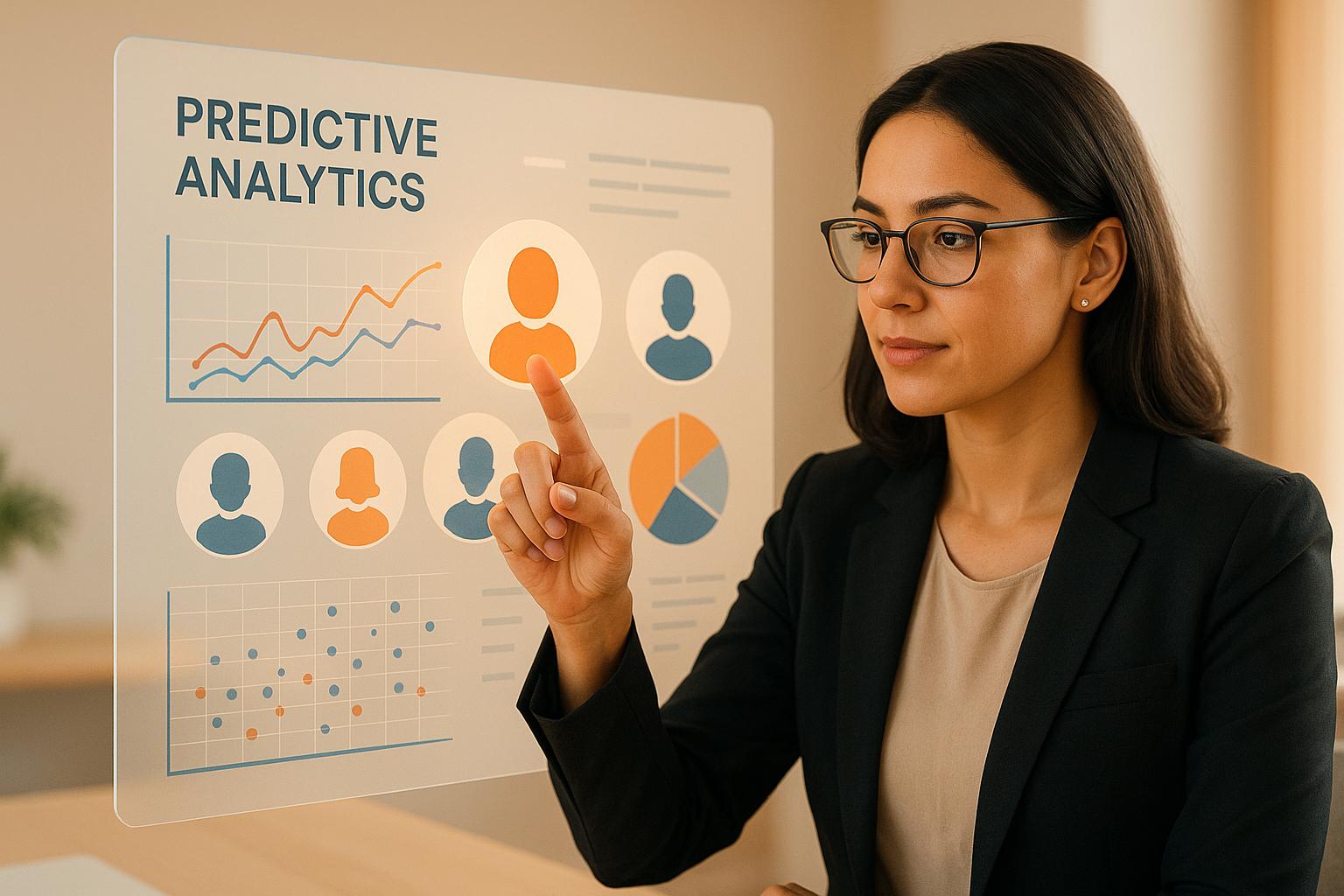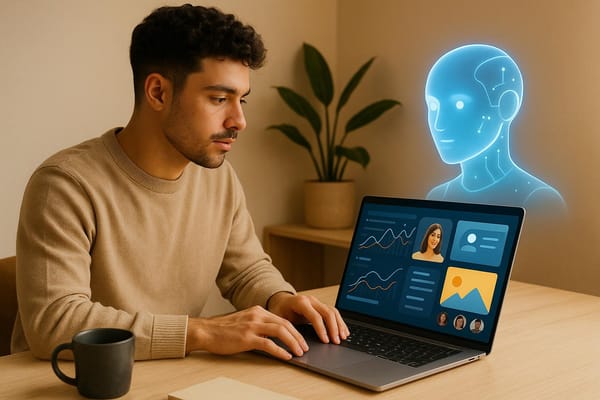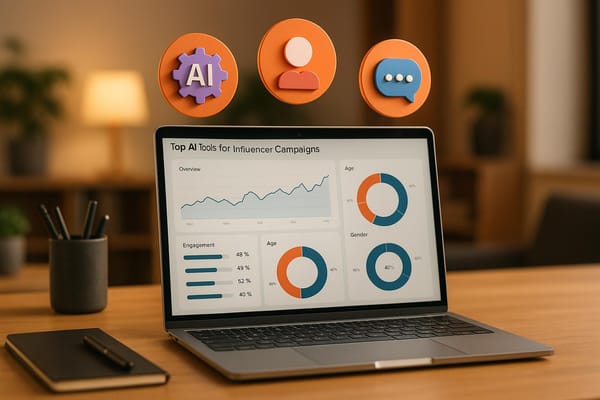AI Tools for Matching Influencers to Brand Stories
Explore how AI tools are revolutionizing influencer marketing by enhancing match accuracy, campaign efficiency, and audience engagement.
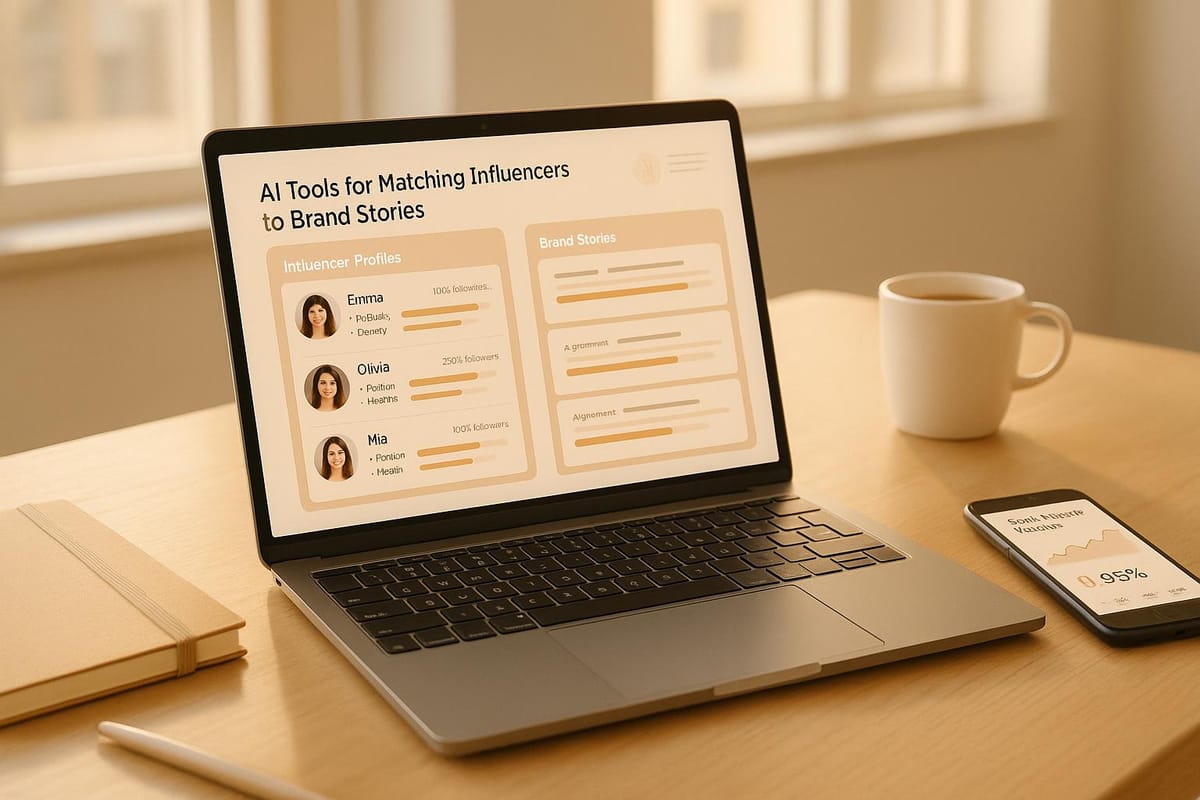
Influencer marketing is growing fast, but finding the right match is still a challenge. AI tools are solving this by helping brands connect with influencers who truly align with their values and stories, saving time and improving results.
Key Takeaways:
- The global influencer marketing industry reached $21.1 billion in 2023.
- 54% of brands still rely on manual methods to find influencers, which often leads to mismatches.
- AI tools analyze audience demographics, engagement, and sentiment to find the best-fit influencers.
- Predictive analytics forecast campaign success, improving efficiency by 15–20%.
- Automation simplifies outreach and management, saving marketers up to 120 hours per campaign.
AI is transforming influencer marketing by making the process faster, more accurate, and data-driven. Brands using AI tools report higher engagement, better campaign results, and stronger connections with their audiences.
Influencer Marketing with AI: All You Need to Know
The Challenges of Finding the Right Influencers
While influencer marketing offers undeniable advantages, pinpointing the right collaborators isn't as straightforward as it seems. Manual methods often fall short, and poor partnerships can lead to wasted resources and damage to brand credibility. These challenges not only disrupt engagement metrics but also weaken the emotional connection necessary for authentic storytelling. One of the biggest hurdles? Navigating the overwhelming sea of potential influencers to find a true match.
Too Many Options and Difficulty Vetting Influencers
The sheer number of influencers available today can be paralyzing. On Instagram alone, there are over half a million influencers, making it nearly impossible to sift through them manually. This abundance often forces brands to rely on surface-level data, like follower counts, while overlooking key factors such as whether the influencer's audience aligns with the brand or if their content meets quality standards.
A report by Influencer Marketing Hub reveals that 22% of marketers find it extremely difficult to identify the right influencer for their brand, while 56% describe it as moderately challenging. With over 67% of brands increasing their influencer marketing budgets, the stakes are high, yet nearly 55% have encountered brand safety issues due to insufficient vetting. Adding to the complexity, Sprout Social’s Q1 2025 Pulse Survey found that more than a third of brands (36%) juggle partnerships with six to ten influencers at a time, making efficient management nearly impossible without the right tools.
Fake Engagement and Lack of Transparency
Another major issue is fake engagement, which undermines the trust and effectiveness of influencer campaigns. Buying fake followers is alarmingly easy and cheap - 1,000 followers cost $49 on YouTube, $34 on Facebook, $16 on Instagram, and $15 on Twitter. In 2019, brands in the U.S. and Canada spent roughly $1.9 billion on influencer marketing, with an estimated $255 million going to fake influencers.
Studies show that influencers, on average, purchase about 23% of their followers, and 30% have been flagged for buying engagement. Even more concerning, nearly 90% of influencers fail to engage with at least half of their audience. Metrics like engagement rates can be off by as much as 55%, and influencer-generated impressions are often overestimated by 48%. Unsurprisingly, 50% of marketers surveyed by Startup Bonsai cited spotting fake followers and inauthentic engagement as their top challenge.
Time-Consuming Outreach Processes
If fake engagement wasn’t enough, the outreach process itself is another major bottleneck. Manual efforts to vet and connect with influencers can drag campaigns to a halt. Marketers spend an average of 120 hours per campaign managing influencer partnerships, time that could be better spent on strategy and creative work.
This process involves a tedious series of steps: reviewing individual profiles, analyzing engagement metrics, checking for brand safety risks, verifying audience demographics, and then manually searching for contact details. Over half of marketers (55.86%) say that selecting quality influencers is their biggest challenge. While personalized outreach can increase engagement by up to 30%, and follow-ups can boost reply rates by up to 40%, managing these communications across multiple campaigns is overwhelming. In fact, as much as 60% of influencer budgets may be wasted on partnerships with low-quality or fake audiences.
How AI Tools Transform Influencer Matching
Artificial intelligence is reshaping influencer marketing into a precise, data-focused strategy. Between 2020 and 2025, the use of AI tools skyrocketed from 116 million to 379 million users. Today, about 60% of marketing professionals already rely on AI, with many reporting improved results in their influencer campaigns.
Data-Driven Influencer Discovery
AI takes the guesswork out of finding the right influencers. It evaluates factors like demographics, engagement rates, content focus, and brand compatibility to pinpoint the best matches. Unlike human reviewers, AI can detect patterns that are easy to overlook. It even analyzes the sentiment behind audience interactions to ensure influencers have authentic, engaged followers, not just bots.
This technology digs deeper into alignment by assessing how well a brand’s style and values mesh with an influencer’s content and audience. For example, a skincare company can leverage AI to scan captions, hashtags, and images, ensuring they align with themes like self-care, positivity, and dermatological safety before moving forward with collaborations.
Imagine a fitness brand searching for micro-influencers. AI can identify creators who consistently post about health and wellness while maintaining high engagement with health-focused audiences. It doesn’t stop there - AI also considers follower interests, locations, demographics, and psychographics to provide a full picture of compatibility.
Once the right influencers are found, predictive analytics step in to forecast campaign success with data-driven confidence.
Predictive Analytics for Campaign Success
Predictive analytics can increase campaign efficiency by 15–20%. AI tools help brands predict outcomes before a single post is published, ensuring they partner with creators who genuinely resonate with their audience while flagging potential fraud early on.
Influencer marketing delivers impressive returns, generating $5.78 in revenue for every $1 spent. Some brands even see returns as high as $18 per dollar, with 74% now directly tracking sales from influencer campaigns.
These predictive models work by analyzing past data to highlight trends linked to success. They reveal audience preferences for content format, tone, style, and even the best times to post. This approach allows brands to shift from reacting to results to proactively designing campaigns that hit the mark.
"eliminates guesswork and gives you an accurate picture of your brand sentiment within minutes" – talentresources.com
But AI’s impact doesn’t stop at discovery and analytics - it also streamlines outreach with powerful automation.
Automation for Faster and Accurate Outreach
AI-powered automation slashes the time and effort required for influencer outreach. Generative AI can craft personalized outreach messages by analyzing an influencer’s content and interests. It can also suggest potential partnerships based on a brand’s goals and niche, while enabling A/B testing for email subject lines or pitch angles.
After initial outreach, AI automates follow-ups with a personal touch. It simplifies onboarding tasks like contract signing and brief distribution, and even tracks whether influencers have posted their assigned content. According to studies, over 42% of respondents reported enhanced content creation and campaign efficiency thanks to automation tools like generative AI.
For instance, a startup used AI to create outreach variations and automate follow-ups, resulting in a 20% boost in online store traffic and a 12% increase in sales.
AI also speeds up fraud detection by evaluating the quality of an influencer’s followers. It estimates campaign outcomes for specific influencer combinations and automates administrative tasks like tracking invoices and payments.
With these tools, brands can build influencer partnerships that deliver authentic and impactful stories. It’s no wonder nearly 55% of marketers view AI as a game-changer for improving efficiency. For brands aiming to excel in influencer marketing, AI is quickly becoming indispensable.
Key Features of Media AI for Influencer Matching
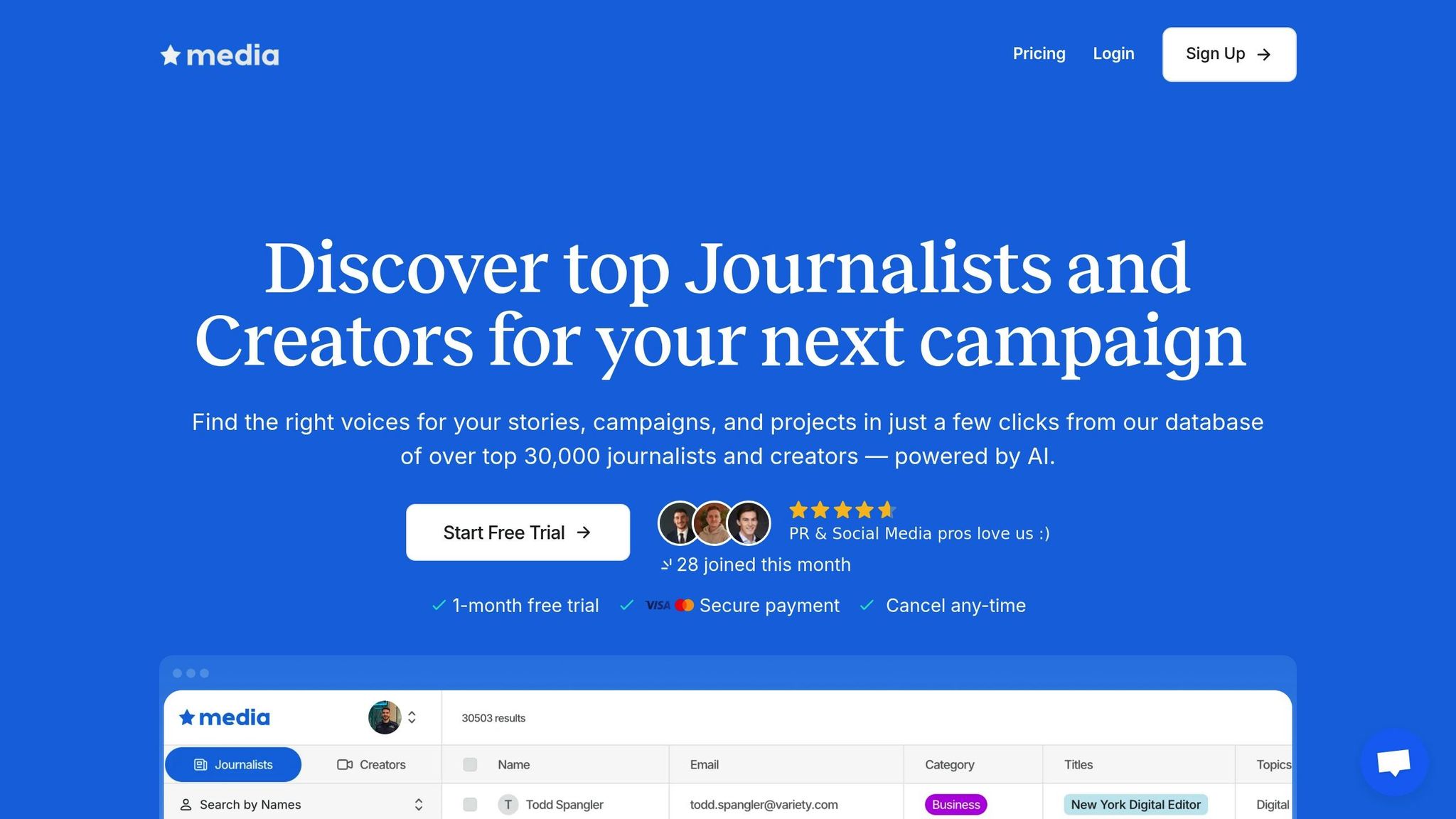
Media AI simplifies influencer matching with a data-driven approach. With the influencer marketing industry projected to hit $71.04 billion by 2032 and 74% of shoppers influenced by recommendations from creators, having the right tools is critical. Media AI addresses common challenges like outdated contact lists, ineffective filtering, and unclear pricing, making it easier for brands to run successful influencer campaigns.
Extensive Database of Journalists and Creators
Media AI boasts a database of 30,000+ journalists and creators, offering a broad spectrum of options for brands seeking impactful collaborations. This network spans various industries, niches, and audience demographics, ensuring PR professionals and marketers can connect with creators who align with their goals.
The platform provides detailed profiles, including content focus, audience engagement stats, and regularly updated contact information. This level of insight helps brands find creators who genuinely reflect their values, rather than relying solely on follower counts for decisions.
Additionally, Media AI covers platforms like Instagram and LinkedIn, making it easier to plan cross-platform campaigns that cater to audiences’ preferred content formats.
Advanced Filtering and Export Tools
With its advanced search and filtering features, Media AI allows brands to pinpoint creators based on audience demographics, engagement rates, content categories, geographic location, and brand affinity scores. Once identified, contact information and performance metrics can be exported in CRM-compatible formats for seamless integration.
These tools are especially useful for brands with specific campaign needs. For example, a sustainable fashion brand can filter for creators who focus on eco-friendly lifestyles, appeal to audiences interested in ethical consumption, and maintain engagement rates above industry standards.
Real-time analytics further enhance the platform by offering insights into which types of creators perform best for specific industries. These analytics enable brands to fine-tune their strategies and improve targeting for future campaigns.
"Using an AI influencer may make more sense than using a human influencer in certain situations, such as when cost, control, or niche targeting are critical factors." - Ariel Sims, Senior Vice President of Paid Social, Digitas
Transparent Pricing and Flexible Plans
Media AI combines powerful discovery tools with straightforward pricing. Unlike many platforms that hide fees or require long-term contracts, Media AI offers clear monthly plans with no obligations.
| Plan | Monthly Price | Access | Key Benefits |
|---|---|---|---|
| Journalist Database | $99 | Full journalist contacts | Advanced filtering, export options, no contracts |
| Creators Database | $99 | Full creator contacts | Advanced filtering, export options, no contracts |
| Full Database | $149 | Both journalists and creators | Advanced filtering, export options, no contracts |
This pricing model is ideal for startups, freelancers, and small agencies looking for professional tools without the burden of enterprise-level commitments. The flexibility to scale up or down based on campaign needs is particularly beneficial for growing businesses.
The no-contract approach also allows brands to test the platform without financial risk. Research shows that 66.4% of marketers see better results when incorporating AI into their influencer campaigns.
Media AI’s user-friendly interface further enhances its appeal. Unlike complex systems that take weeks to master, users can start discovering and connecting with creators almost immediately after signing up. This ease of use makes Media AI a practical choice for marketers at all experience levels.
Best Practices for Effective Influencer-Brand Storytelling
Creating successful influencer campaigns requires a mix of solid data and compelling storytelling. With 63% of marketers incorporating AI into their influencer strategies, it's clear that technology is playing a pivotal role in shaping these campaigns. However, the real magic happens when brands combine these tools with narratives that genuinely connect with audiences, fostering meaningful relationships between influencers and brands.
Define Clear Objectives and Storytelling Themes
Before diving into influencer partnerships, brands need to establish clear goals and a strong storytelling framework. While AI can analyze vast amounts of data to identify influencers who align with your brand, it works best when guided by well-defined objectives.
Start by determining your campaign's purpose - whether it's increasing brand awareness, driving sales, or boosting engagement. Each goal will influence how you choose influencers. AI tools are particularly helpful here, as they can evaluate how well an influencer’s content aligns with your brand’s values and tone. This makes it easier to identify creators whose natural style complements your message.
Sentiment analysis is another powerful tool. It helps gauge public perception, allowing brands to avoid partnerships that might harm their reputation and instead focus on creators who already have positive associations with similar products or values. AI can even classify content by style, topic, or age rating, ensuring that potential partners align with your brand's tone. For instance, a family-oriented company can use these insights to find influencers who consistently produce content suitable for their audience.
A great example of leveraging AI is Heinz, which used AI-driven design to create unique ketchup bottle designs. This campaign generated 850 million impressions and saw a 38% increase in engagement.
Once your objectives are clear, use real-time AI insights to adjust and refine your campaigns dynamically.
Use AI Insights to Adapt to Trends
AI-powered analytics allow brands to stay agile, adapting campaigns to emerging trends and audience behaviors. For example, AI can reduce the time spent on influencer discovery and outreach by up to 80%. This efficiency not only saves resources but also gives brands the flexibility to optimize campaigns as trends evolve.
Predictive analytics take this a step further by forecasting future performance trends based on current data. This means brands can anticipate shifts in audience preferences and market dynamics, ensuring their campaigns stay relevant and timely.
Big names like Kylie Cosmetics and PepsiCo have used AI analytics to supercharge their influencer campaigns, achieving performance increases of 18% and 34%, respectively.
AI also enhances content optimization. By analyzing data on what resonates with audiences - whether it’s specific hashtags, visuals, or messaging - brands can provide influencers with actionable insights while still allowing room for creative freedom. This balance ensures that content feels both engaging and authentic.
"Data really powers everything that we do." – Jeff Weiner, American businessman
The key is to combine the precision of AI with human creativity. By identifying trends and audience shifts, brands can craft campaigns that connect on a deeper level. A/B testing strategies based on AI recommendations can further refine approaches to resonate with target audiences.
While data shapes strategy, the foundation of success lies in authentic relationships.
Focus on Genuine Relationships with Influencers
AI can streamline influencer discovery and vetting, cutting down time by as much as 70%. But while technology simplifies these processes, the heart of a successful campaign lies in building genuine, long-term relationships with creators. The time saved through AI should be reinvested in nurturing these partnerships.
Long-term collaborations, for instance, can increase engagement by up to 300%. These relationships allow influencers to build genuine connections with the products they promote, leading to more authentic and relatable content for their audiences.
AI tools can also track how an influencer’s content evolves over time, using predictive models to ensure ongoing alignment with a brand’s values. This approach provides a strong foundation for sustainable partnerships.
Treat influencers as more than just marketing tools - see them as strategic partners. Celebrate milestones, engage with them beyond sponsorships, and create an environment of trust. This approach turns influencers into true advocates for your brand.
AI can also identify creators who naturally mention your brand or have a history of unpaid content related to your products. These organic connections often lead to partnerships that feel more authentic to the influencer’s audience.
"Influencer marketing isn't just about reach: it's about relationships." – Martynas Siuraitis, SEO Consultant, The SEO Consultant Agency
Co-creating content with influencers often results in posts that feel more natural and relatable. By giving creators the freedom to express themselves - while using AI insights to guide audience preferences - brands can achieve a balance between authenticity and effectiveness.
Regular communication is essential to maintaining these relationships. While AI can track key performance indicators in real time, it’s just as important to discuss these findings with influencers. Understanding the story behind the numbers helps both parties plan future content and strengthen the partnership.
Conclusion: The Future of Influencer Matching with AI
The landscape of influencer marketing is shifting rapidly, with AI driving a new era in how brands find, evaluate, and collaborate with creators. This technology is bringing a level of precision and authenticity to brand storytelling that was once unimaginable.
AI is transforming influencer discovery and campaign performance. Brands that tap into AI-driven insights report up to 20% higher conversion rates, while data-backed attribution models are improving marketing efficiency by over 30%. These advancements provide a clear edge for companies looking to stay ahead.
Virtual influencers are also making waves, with 58% of consumers already following at least one. Platforms like Media AI are making sophisticated influencer discovery more accessible, offering a database of over 30,000 creators at transparent pricing starting at just $99 per month - no long-term contracts required.
One of AI's most game-changing capabilities is micro-targeting at scale. Brands can now spot emerging influencers early, forecast campaign success with greater accuracy, and detect fraudulent engagement before it affects their investments. Just a few years ago, this level of precision seemed out of reach.
FAQs
How can AI tools make it easier to find the right influencers for a brand's story?
AI tools make it easier and faster to find influencers who genuinely fit a brand's story by offering speed, accuracy, and data-backed insights. Instead of relying on time-consuming manual searches, AI can sift through massive amounts of data in seconds to pinpoint influencers whose style, values, and audience engagement align with your brand. This not only ensures a better fit but also cuts down the time spent on research and outreach.
By automating tasks like assessing compatibility and tracking campaign performance, AI tools save valuable time while delivering better outcomes. For instance, real-time analytics allow brands to adjust strategies on the fly, resulting in higher ROI and more meaningful partnerships. Platforms like Media AI make it simple for brands to discover and connect with the right creators, streamlining the entire process from start to finish.
What risks do brands face when partnering with influencers with fake engagement, and how can AI help address these issues?
Partnering with influencers who rely on fake engagement can seriously damage your brand's reputation, drain your marketing budget, and result in campaigns that fall flat. Inflated follower counts and artificial engagement metrics give the illusion of influence, often tricking brands into collaborations that deliver little to no real value.
To avoid this pitfall, AI-powered tools can be a game-changer. These tools analyze engagement patterns, flag suspicious activity, and verify the authenticity of an influencer's audience. By using them, you can ensure you're working with genuine influencers who truly resonate with their followers. This not only safeguards your brand but also helps you make smarter use of your resources and achieve more impactful campaign outcomes.
How does predictive analytics make influencer marketing campaigns more effective?
Predictive analytics taps into historical data to anticipate future trends and results, giving brands a powerful tool to pinpoint the influencers and strategies that will make the biggest impact. This means campaigns can zero in on creators who are more likely to boost engagement and drive conversions, ultimately saving both time and money.
By using these data-driven insights, brands can fine-tune their targeting, allocate budgets with greater precision, and enhance the return on investment (ROI) of their influencer marketing campaigns. It’s a smarter, more streamlined approach to matching the perfect influencers with the right brand narratives.


